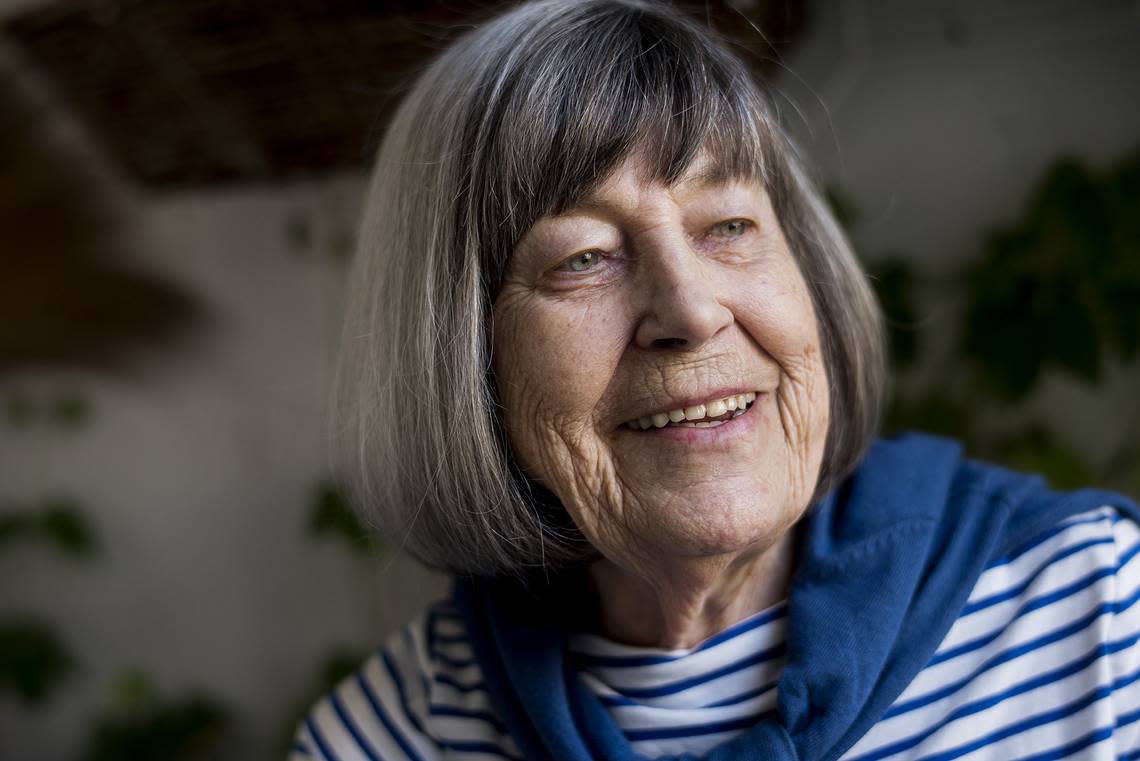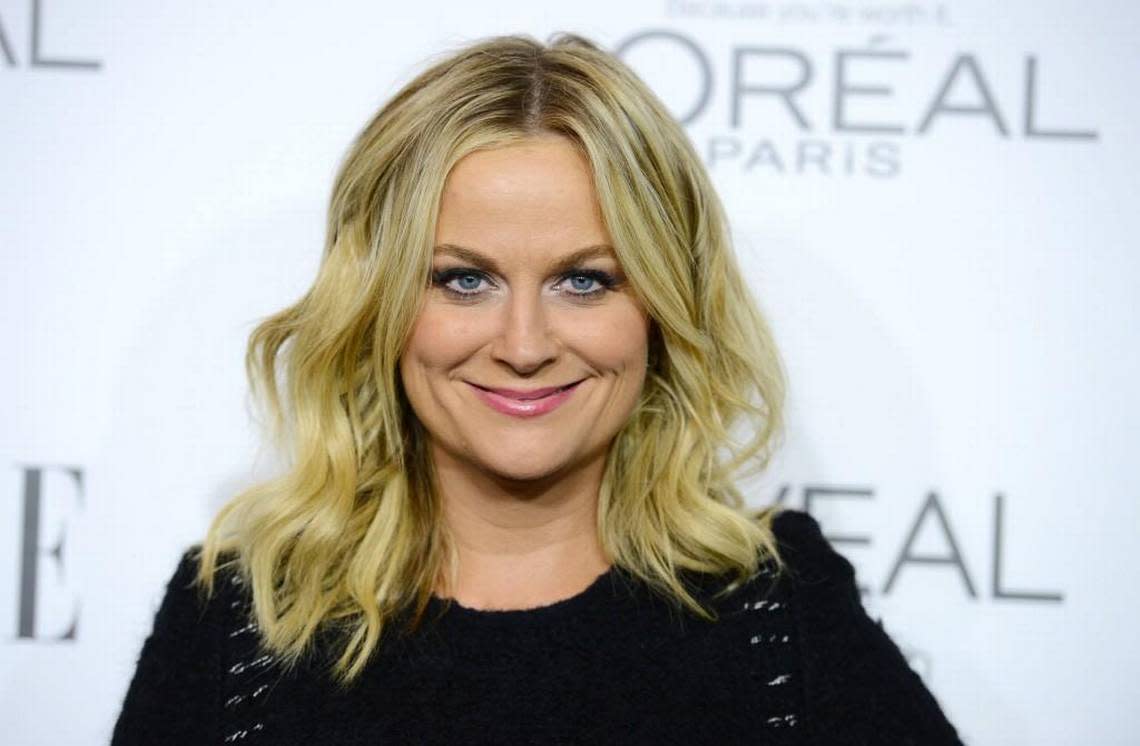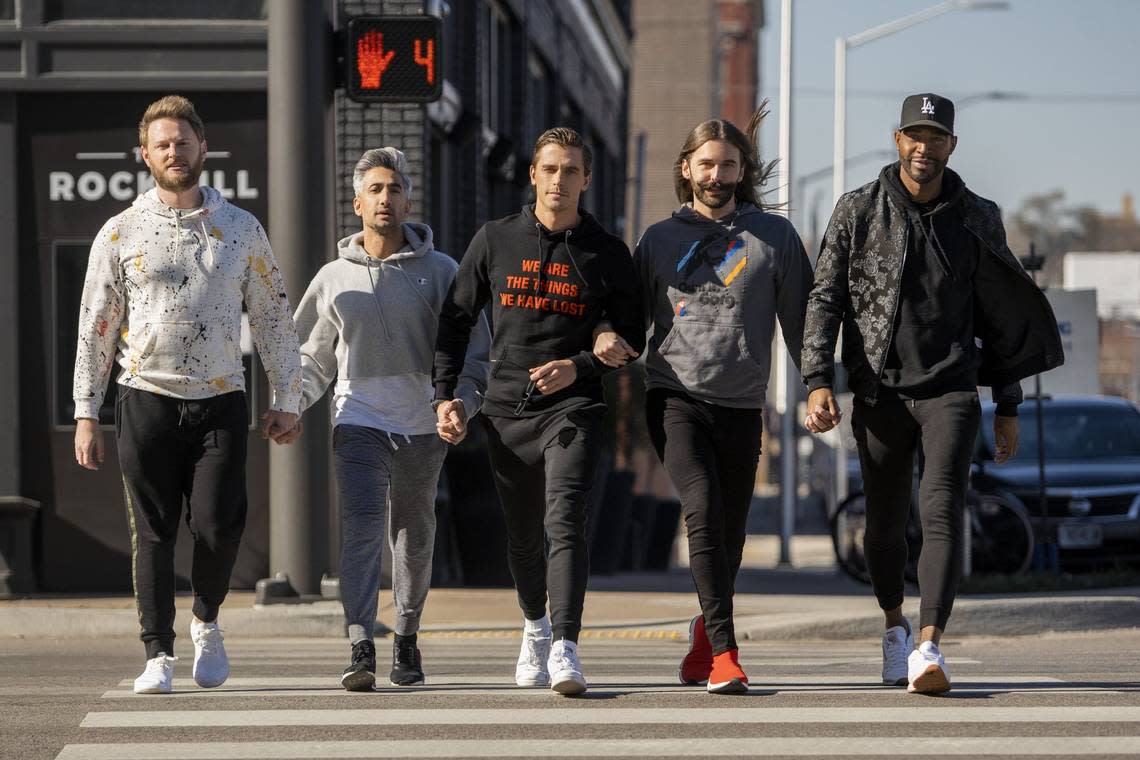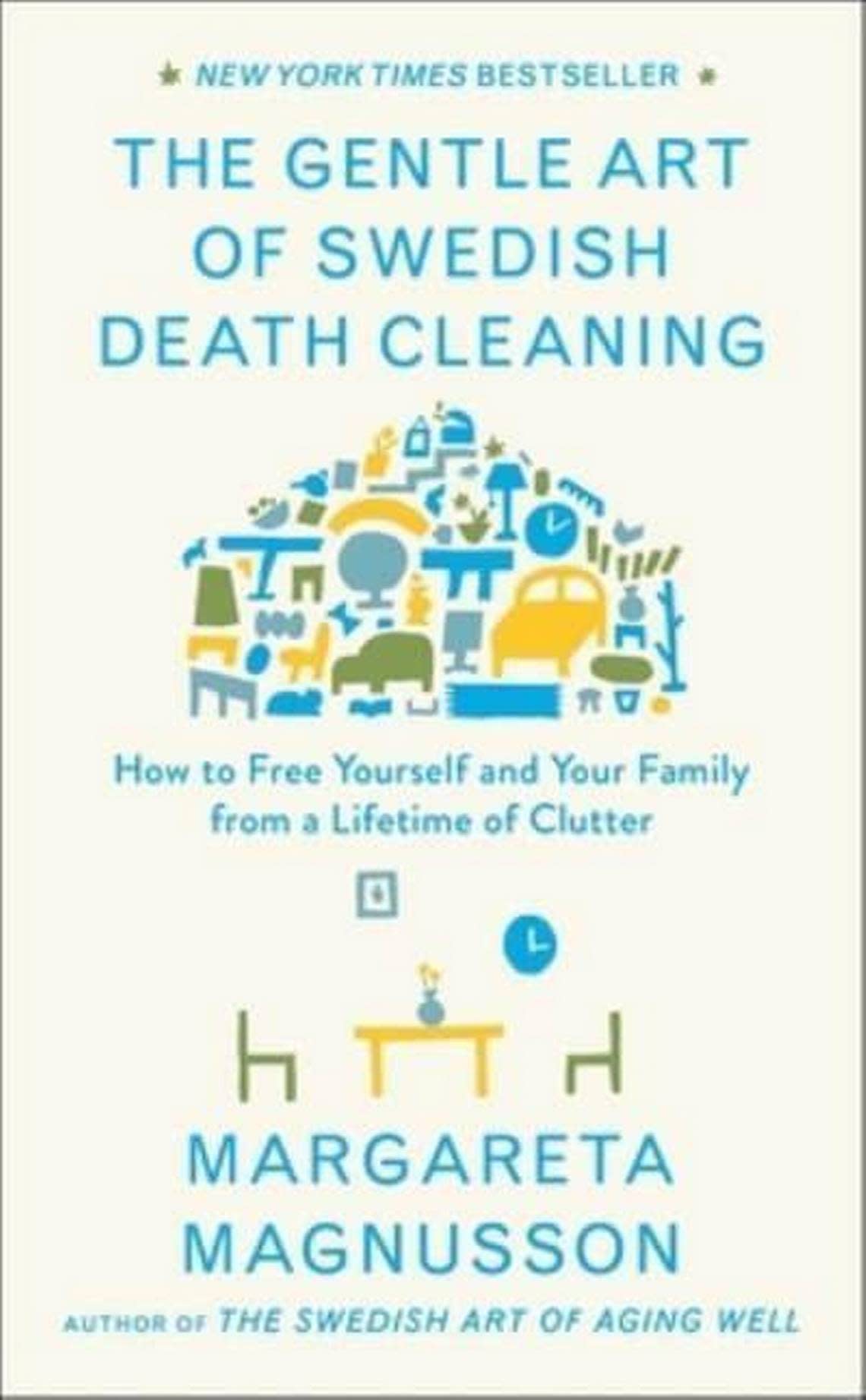‘Queer Eye’ producers teach KC families Swedish death cleaning in new reality show
The painting was, well, kind of ugly. And big. At least four-feet across. And it held a place of honor over the fireplace in a Kansas City home that looked like someone much older than the homeowner lived there.
She hated the painting but kept it there for 10 years — because her mother gave it to her, along with a lot of other unwanted stuff in her house.
Then Oscar- and Emmy-winning producer Michael Williams and a reality TV show from Los Angeles came along and gave her permission to get rid of it.
America is about to learn how to let go of all that stuff tucked away in closets, basements, garages and storage units with the help of eight Kansas Citians.
They are participants in a new Netflix series called “The Gentle Art of Swedish Death Cleaning,” inspired by the popular 2018 book of the same name by Swedish artist and mother of five Margareta Magnusson.
Crews filmed the inaugural season in the Kansas City area over the summer, wrapping up around Labor Day. No air date has been announced yet. The participants haven’t been identified, either.
The show comes from the creators of the hit Netflix series “Queer Eye.” It will introduce viewers to the Swedish practice of döstädning — dö means “death” and städning means “cleaning.”

“For me it means going through all my belongings and deciding how to get rid of the things I do not want anymore,” Magnusson writes. “Just look around you. Several of your things have probably been there for so long that you do not even see or value them anymore.
“It does not necessarily have to do with your age or death, but often does. Sometimes you just realize that you can hardly close your drawers or barely shut your closet door.”
Death cleaning can take years, Magnusson cautions. For the show, the first steps will take place within the confines of a one-hour episode. In each, three experts will walk a “hero” through a thoughtful purge.
The participants came from all walks of life on both sides of the state line, said Williams, a co-producer. They were empty nesters, single folks, families.
Letting go got emotional. Drama ensued. In one episode a dying woman threw a dinner party for her friends, then chided them for abandoning her when she got sick because they’re afraid to talk about death. I want to talk about it, she challenged them.
“You don’t need to have death surrounding it, certainly that accelerates a need to do it,” Williams told The Star. “But it’s decluttering your life and not just cleaning out a messy drawer. But going through storage, going through closets, looking under the bed.
“Do I need this? Do I use this anymore.? Am I going to pass all this stuff along to my children? Someone’s going to have to go through it and why not start now?”
Williams, co-founder of Scout Productions, is executive producer of “Queer Eye” and producer of the 2003 film “The Fog of War,” which won an Oscar for best documentary feature.
Amy Poehler, “Saturday Night Live” and “Parks and Recreation” alum, is also a co-producer of “Swedish Death Cleaning” and will narrate the series but won’t be seen on camera.
There was concern that people would balk at the word “death” in the show’s title, Williams said, which is why they approached Poehler. She’s funny and is interested in matters of the home. She and her former “Parks and Recreation” co-star Nick Offerman co-host a crafting competition for NBC called “Making It.”
“So Amy is going to be our narrator, so she will certainly bring the humor into this,” Williams said.

What is Swedish death cleaning?
When the book debuted, Vogue declared that Swedish death cleaning is not as scary as it sounds.
“After the long supremacy of Marie Kondo, Magnusson’s is the slow-food version of organizing,” wrote Eve MacSweeney. “Where Kondo advises an all-or-nothing approach, noting that clearing up bit by bit would take you the rest of your life, Magnusson appears to have the rest of her life to do it.
“… She advocates a methodical, thoughtful process, perusing the contents of each room in your home at your own pace before deciding whether to gift, recycle, ditch, etc.”
The first step? Start pulling things out of storage, Magnusson writes in the book. Then consider: Who do you think will take care of all that when you are no longer here?
She is a disciple of the less-is-more philosophy, sermonizing that “mess is an unnecessary source of irritation.” Thanks to COVID-19 she’s preaching to a new, enthusiastic choir. Quarantined and stuck at home, people began rethinking their surroundings and belongings.
The show’s eight participants craved the peace of minimalism, each for different reasons.
One person lost both parents within two years and inherited everything they owned. “The entire contents of their parents’ house were in their basement, and they hadn’t gone through it,” said Williams.
The participant with Stage 4 cancer didn’t want people going through her belongings and just throwing things away after she dies.
“So some of the stories, people are dying or facing death, and other people aren’t. They’re just, they’ve got a bunch of junk,” said Williams.
“One guy’s fiancee wouldn’t move into his messy house because it was filled with a lot of his ex-wife’s stuff, who he hated by the way and had a bitter divorce. But he still couldn’t get rid of her stuff. So it’s all sorts of stories like that.”
Williams got a taste of how universal those themes are when he visited the Thomas Hart Benton Home and Studio on Belleview Avenue while he was in town.
The only other person on the tour that day had come from Arizona to help his mother downsize before moving into assisted living. She lived in a huge, three-story home, and all her children had come to Kansas City to go through the house.
“Everyone has a story to resonate with what we’re doing,” said Williams.

Why Kansas City?
Williams first visited Kansas City in the 1990s as the location manager for “Truman,” an HBO TV movie about President Harry S. Truman starring Gary Sinise.
Fast forward nearly 30 years and Williams was producing the Emmy-winning “Queer Eye.” After shooting the first few seasons in Atlanta, the show had strong ratings on both coasts.
Then Netflix asked producers to change things up and hit Middle America. Williams suggested Kansas City, and that experience of shooting two seasons of “Queer Eye” here led him back to Kansas City for “Swedish Death Cleaning.”
The Kansas City Film Office had given “Queer Eye” royal treatment, “from what restaurant should we eat at to ‘I need a city bus tomorrow’ or ‘we need to close this street,’” said Williams.
“In other cities, when there’s a lot of other big projects, you can’t have that hand-holding … and we like to have our hands held. Everyone loved it. Crew members loved it. The cast loved it. Everybody had a great, great, great time.
“So when it came up to ‘Swedish,’ and the typical thing to save money is to shoot it in L.A., we just said absolutely not.”
Williams likes the physical diversity of Kansas City, “how neighborhoods all look different from each other. When you film a show in Los Angeles, no matter where you go in the valley, you’re basically going to have a … one-floor, stucco, California-type house. Well, Kansas City has a wide variety of architecture styles. We love that.”
Plus the people here, true to what people think of Midwesterners, “are just open to everything. Every neighborhood we went in, it was ‘Oh, you’re filming a TV show. That’s great.’
“And not to make it sound like we came there just because of traffic, but getting around Kansas City is so easy,” said Williams, who lives in L.A. “I just had to go to my daughter’s soccer game and it took me an hour and 10 minutes to get home. And it was 15 miles.”
Filming “Queer Eye” here was leisurely by comparison. Everyone could get to set in 10, 15 minutes, “and we were able to take hour-long lunches, which is rare in this business, and we got to relax,” he said.

What the show will look like
A show about a Swedish tradition begged to have Swedish experts involved.
“And certainly the Swedes can talk about death a little more easier than Americans,” said Williams. “So we thought at first when we got the book … well, OK, look up in the phone book all the Swedish death cleaners. Well, that didn’t happen. It’s sort of a method, it’s really not a profession.
“So we put out the casting call to find people who were experts whether in organizing, design, one was a psychologist who deals with people’s issues and putting them all together.
“And we flew about 20 of them from Sweden to L.A. for what we call a chemistry test. Who works together well? Who has a good skill set?”
But finding three Swedes to go in front of a camera was harder than getting a Kardashian to stay away from one. Producers were confused about why they couldn’t get more Swedish experts interested in being on the show.
“Well, one, the culture is way more reserved,” Williams said. “Here in the U.S. you go up to anyone and say hey, you want to be in a reality show? Yeah, sure.
“There? No. A lot of professionals, no. They look down their noses — oh I don’t want to be on an American reality show.
“And also, it finally dawned on us why we didn’t have a lot of people because our casting people (said) you realize the entire population of Sweden is smaller than L.A. County.”
Not an HGTV show
“Swedish Death Cleaning” is “not an HGTV Chip and Joanna Gaines kind of makeover show,” Williams said.
Yes, there might be a little painting to freshen up, lighten up a room, make it more “Swedish looking” — uncluttered, pared down. Think the Ikea look.
But they’re not knocking down walls. At least not the drywall kind.
“I thought this show was decluttering my life and my house. You’ve decluttered my mind and my soul,” one participant told Williams.
The woman with the ugly painting from her mother had been living with guilt for years, Williams said, which is why “her house was fine but it looked like an old lady’s house and we’re like why is this an old lady’s house?
“Well her mother keeps giving her stuff and even though she doesn’t like it she felt guilty about saying no. So the house wasn’t her at all.”
So the “Swedish Death Cleaning” team donated a bunch of it and bought her new furnishings, finding surprises along the way.
“The dining table that she hated, that she thought was this family (heirloom)? We realized her mother bought it at a garage sale. But she kept it for all these years — too small for the room, didn’t fit, and it was ugly — because her mother gave it to her,” said Williams.
“And then … her mother said, ‘Oh yeah, I got that at a yard sale.’”
The homeowner’s young children quickly figured out this circle of strife. Their mom got Grandma’s stuff, which meant someday they would inherit all of that plus their mom’s stuff.
Said the 10-year-old: Let’s stop this now.
“There’s a lot of that. It just keeps happening down generation to generation that you keep passing stuff along,” Williams said. “And you’re like, ‘So what am I going to do with it?’”
Don’t throw it away
One participant still had all his metal Tonka trunks from his childhood.
“Well, I had those same Tonka trucks when I was a kid, but I’m like, what are YOU going to do with them? Yes, there’s a memory, you’ll look at them for a second. But what are you doing with them in your storage,” said Williams. “Why don’t you donate them, find some kid who could use them and love them and reuse them?”
In the beginning there was talk of getting a big dumpster and just hauling people’s stuff away.
“I said no, no, no, no. There’s no dumpster,” Williams said. “Everything has a home, whether it’s finding it a new home or giving it away or recycling something in the proper way. I’m fanatical about that, I always have been.”
So the show got creative. One woman had collected quite a bit of art by LGBTQ and Hispanic artists in Kansas City and had no room for it all anymore. So she donated some to a museum in Chicago that showcases Latina art. And then the show threw an art show and sale.
Working on the series has put Williams in a Swedish death cleaning frame of mind. The chemistry test for the experts from Sweden took place at his house, where he pulled boxes and boxes of his own stuff from storage. The light-bulb moments in his own life keep coming now.
He’s had his grandmother’s everyday dishes in storage for 30 years — 10 years in Boston, now 20 years in Los Angeles. Inspired by the show he texted a photo of one of the dishes to his family “and my younger sister who lives in New Hampshire saw it and said, ‘Oh my gosh those are Nana’s dishes, I remember eating tuna sandwiches with pickles on those.’
“And I just said do you want them and she said, ‘I would love to have them.’ I’m like, oh my God, they’ve been sitting in my storage for 30 years and my younger sister would love to have them.”
He hopes the show will inspire people to “take the big-picture look” at everything they own. The stuff you’re paying to store. The stuff hidden in the basement.
Make a plan to go through it. Enlist family members. Hey kids, let’s clean out this storage unit.
“This is what one of our families did. They inherited a lot of their parents’ stuff and their kids were, oh no keep it, that was Grandma’s and Grandpa’s,” said Williams
The parents, though, were tired of paying hundreds of dollars a month for a storage unit, especially since the dad needed the money for something else.
“So we trucked the entire storage unit to their driveway and told their eight kids, ‘You have to go through it now. You take it and then we’re donating the rest,’” Williams said.
“And the kids were fine. And it wasn’t pleasant. Some of them were mad, mad at us, and their parents. Oh we can’t give this away.
“Oh, so we keep it in storage for the rest of our lives and pay for it? What’s the point?”
It’s hard to let go, said Williams. But the heroes of this show have taken those first painful steps, courtesy of a film crew from Los Angeles.
“So hopefully by watching it people will say, OK, I’m going to tackle this next weekend,” he said.
